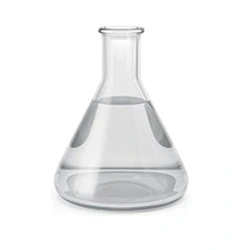IUPAC Name
Acetic Acid
Cas Number
64-19-7
HS Code
29152100
Formula
CH3COOH
Industry
Textile Chemicals
Appearance
Clear Colorless Liquid
Common Names
Ethanoic Acid; Ethylic acid
Packaging
225 @ 80 kg drum, 18 MT
Glacial Acetic acid is the undiluted form of acetic acid. Acetic acid, also known as ethanoic acid, has a molecular formula CH3COOH. It is a weak monoprotic acid which is able to lose a proton from its acid functional group (-COOH) readily and produce a conjugate base, acetate anion. Acetic acid is also a polar protic solvent as it dissolves readily and is miscible in other polar solvents such as water. However, its polar nature makes it insoluble and immiscible in non-polar solvents such as octane. Using acetic acid as a starting reagent, it readily forms other organic reagents such as acetyl chloride and ethanol though substitution and reduction reactions respectively. Acetic acid can also corrode metals such as iron, magnesium and zinc, forming hydrogen gas and metal acetates. But since aluminium forms a protective layer of aluminium oxide on its surface, it is acid-resistance and hence aluminium tanks are used as an option to transport acetic acid. Alternatively, high-density polyethylene (HDPE) drums can also be used to transport acetic acids as due to their resistivity.
Method 1: Carbonylation of Methanol
Acetic acid is manufactured via carbonylation of methanol. Metal carbonyl is added to methanol via rhodium-catalyzed Monsanto process or iridium-catalyzed Cativa process. However, with the introduction of the iridium-catalyzed Cativa process, Monsanto process became obsolete. Due to the economic and environmental friendliness, Cativa process soon became the main process used to manufacture acetic acid.
Method 2: Acetaldehyde Oxidation
Acetic acid is also manufactured via acetaldehyde oxidation, where oxidizing butane and hydrating ethylene via Wacker process obtain acetaldehyde. This crude acetaldehyde is purified by extractive distillation, followed by fractional distillation. This acetaldehyde will further oxidize to acetic acid.
Method 3: Oxidative Fermentation and Anaerobic Fermentation
Acetic acid can also be manufactured via oxidative fermentation using acetic acid bacteria Acetobacter in alcoholic content, and via anaerobic fermentation using anaerobic bacteria Acetobacterium. The Acetobacter method remains more cost effective to produce acetic acid.
Glacial Acetic acid is the undiluted form of acetic acid. Acetic acid, also known as ethanoic acid, has a molecular formula CH3COOH. It is a weak monoprotic acid which is able to lose a proton from its acid functional group (-COOH) readily and produce a conjugate base, acetate anion. Acetic acid is also a polar protic solvent as it dissolves readily and is miscible in other polar solvents such as water. However, its polar nature makes it insoluble and immiscible in non-polar solvents such as octane. Using acetic acid as a starting reagent, it readily forms other organic reagents such as acetyl chloride and ethanol though substitution and reduction reactions respectively. Acetic acid can also corrode metals such as iron, magnesium and zinc, forming hydrogen gas and metal acetates. But since aluminium forms a protective layer of aluminium oxide on its surface, it is acid-resistance and hence aluminium tanks are used as an option to transport acetic acid. Alternatively, high-density polyethylene (HDPE) drums can also be used to transport acetic acids as due to their resistivity.
Method 1: Carbonylation of Methanol
Acetic acid is manufactured via carbonylation of methanol. Metal carbonyl is added to methanol via rhodium-catalyzed Monsanto process or iridium-catalyzed Cativa process. However, with the introduction of the iridium-catalyzed Cativa process, Monsanto process became obsolete. Due to the economic and environmental friendliness, Cativa process soon became the main process used to manufacture acetic acid.
Method 2: Acetaldehyde Oxidation
Acetic acid is also manufactured via acetaldehyde oxidation, where oxidizing butane and hydrating ethylene via Wacker process obtain acetaldehyde. This crude acetaldehyde is purified by extractive distillation, followed by fractional distillation. This acetaldehyde will further oxidize to acetic acid.
Method 3: Oxidative Fermentation and Anaerobic Fermentation
Acetic acid can also be manufactured via oxidative fermentation using acetic acid bacteria Acetobacter in alcoholic content, and via anaerobic fermentation using anaerobic bacteria Acetobacterium. The Acetobacter method remains more cost effective to produce acetic acid.
